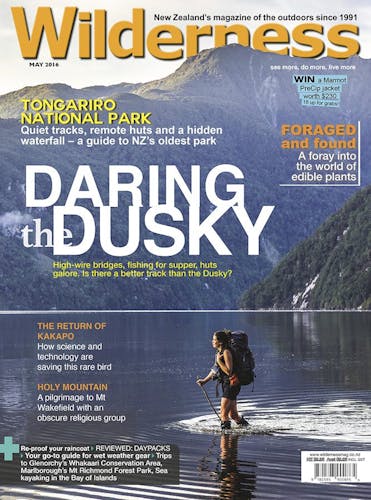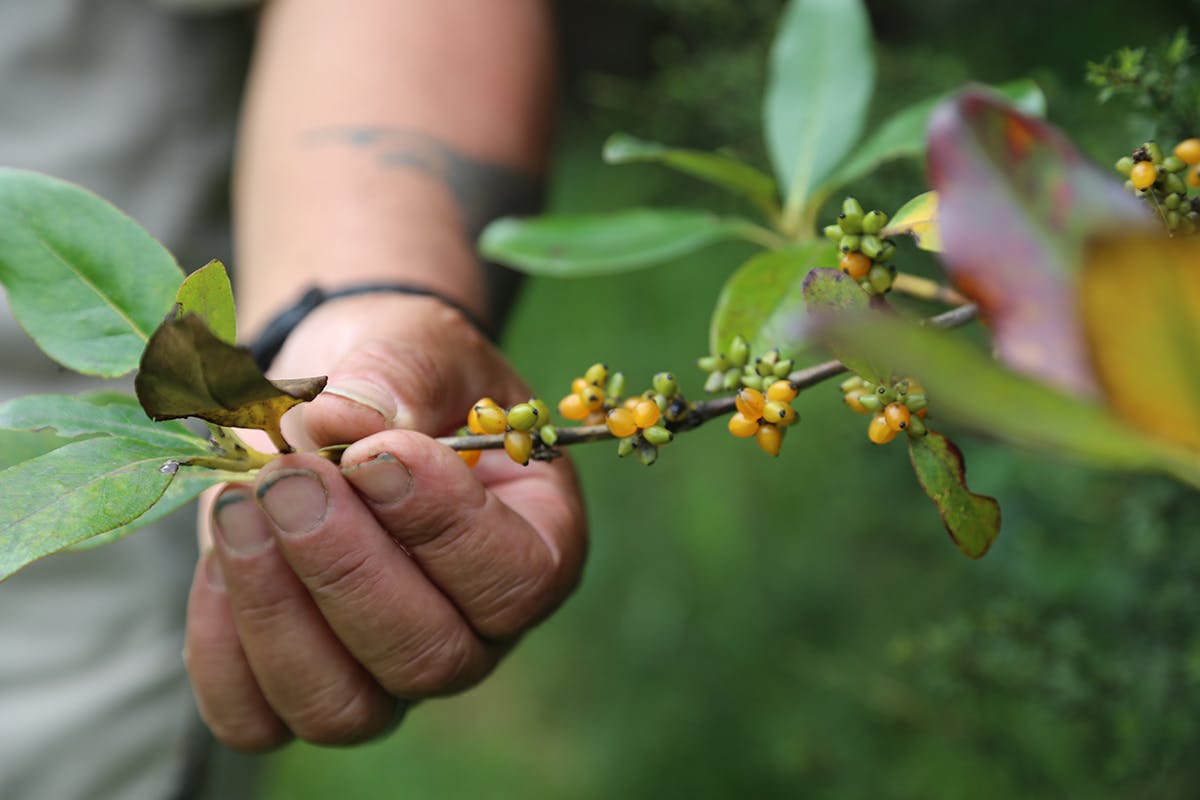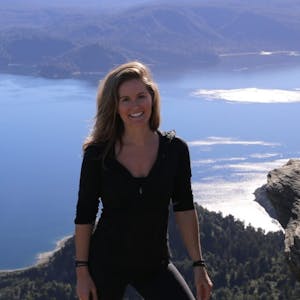Foraging for food isn’t about looking through rubbish bins, it’s about finding organic and healthy fruit, herbs and even roadkill in wild and urban environments. Meghan Walker goes in search of dinner
From lush lowland forests to vibrant ocean shores, New Zealand is positively teeming with abundance. For a keen forager, it’s an absolute gold mine.
Foraging has gained popularity in New Zealand in recent years, with people increasingly more interested in locally sourced food, opting for sustainably harvested produce over imported fruits and veggies. To forage is to search widely for food, a movement which challenges the convenience of supermarket shopping, and encourages people to reestablish an understanding of where their food comes from.
For Christchurch-based Peter Langlands, foraging is a way of life. He says his approach is more scientific than culinary, which is partly a nod to his ongoing research for Massey University and DOC. Much of his research lately has been in the Catlins, monitoring bar-tailed godwits. He also runs a company called Wild Foods New Zealand, taking clients foraging for various edible foods.
Langlands says the greatest areas of abundance are near the sea, where there’s also the most biodiversity. He’s particularly fond of Banks Peninsula, its coastline is rife with edible seaweeds, its hills full of treasured mushrooms. The Maori name for the peninsula is Te Pataka o Rakaihautû, which translates to ‘the storehouse of Rakaihautû’ – named for the legendary Maori explorer.
Langlands says he’s seen foraging become more popular in the last few years as people seek healthy and sustainable alternatives to store-bought produce.The spontaneity of foraging is exciting for Langlands. “You never really know what you’re going to stumble across. It’s really easy to drive past a lot of stuff, but once you get into it, you start seeing opportunities everywhere.”
He recommends those who want to get into foraging take it slow: pick a species, and learn about one plant at a time. “Take photos of things you aren’t sure of, and build a community [with other foragers]. It’s all about sharing observations.”
Langlands promotes foraging and connects with other foragers through his Facebook group, Wild Capture, which has over 3,500 likes. He says people are increasingly contacting him for information about plant identification, which he sees as an indication that foraging is gaining popularity in New Zealand.
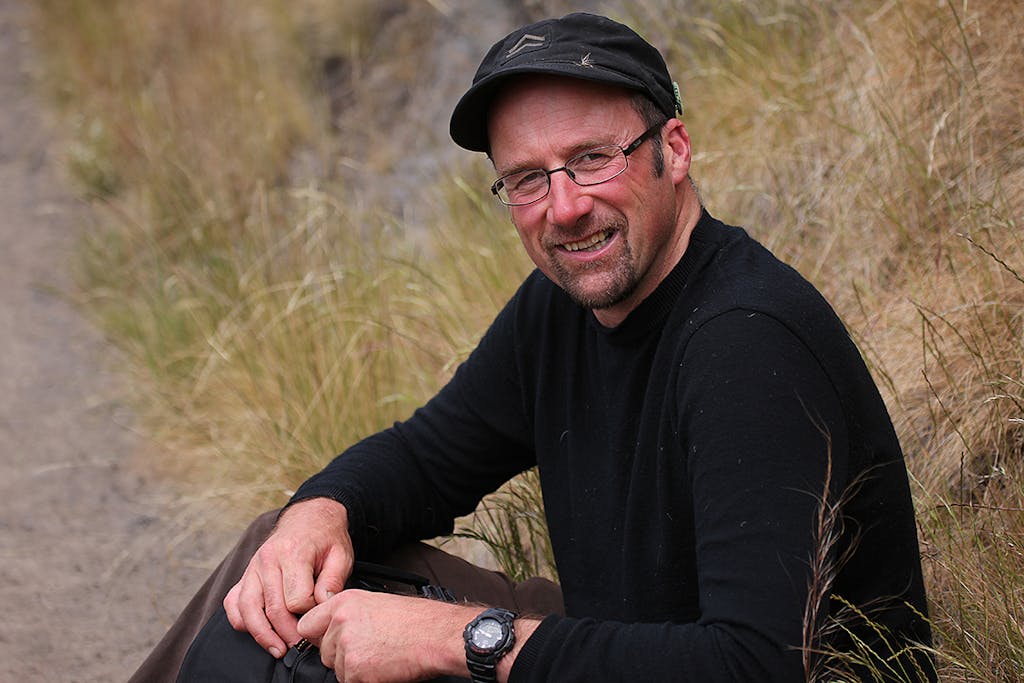
Peter Langlands finds food in the unlikeliest places
Contrary to popular belief, foraging isn’t limited to the great outdoors. Forget about bush-whacking through dense forests – you can find wild food literally anywhere. Urban foraging has taken off in Christchurch after the earthquakes with groups such as Otautahi Urban Foraging connecting city dwellers to areas where edible plants are growing in public places. It uses an interactive map of Christchurch that details the locations of free food in the Red Zone, pinpointing such delicacies as apple trees, grape vines, and patches of watercress. The fruit trees and gardens are typically in the backyards of abandoned homes, and are free for the picking.
Other cities have their own groups: in Auckland there’s ‘Food Foraging West Auckland’, Wellington has ‘Edible Wellington’, and Nelson residents can check out the ‘Nelson Marlborough Fruit Map’ for free food spots. Each group has a map of their own, to which anyone can add new foraging locations.
While Langlands observes a growing interest in foraging among people in his community, he says there’s a real lack of experts who are willing to share their know-how.
“The problem is, people who are quite knowledgeable are more secretive about it,” he says. “It’s the nature of it – secrecy is an important part of sustainability.” Naturally, skilled foragers want to keep their locales under lock-and-key, and are especially quiet about areas where their prized plants are scarce.
Auckland Council ranger Riki Bennett agrees, saying avid foragers protect their resources. But Bennett is making an effort to educate others, regularly leading plant identification workshops for community members and school groups. “I just went foraging for mushrooms this morning!” Bennett says, when Wilderness meets him at Cascade Kauri Park in Auckland’s Waitakere Ranges. It’s mushroom season, he explains, pointing out the small white field mushroom caps dotting the green fields near the car park.
Bennett’s expertise runs deep: he is Maori, and grew up in a small community outside Rotorua where he learned to forage at a young age. Living near the lakes, Bennett spent his childhood looking for freshwater crayfish, watercress and blackberries, which he picked in excess for his mother and grandmother, earning 50 cents a jar. He learned to harvest nikau, identify native berries such as karamu and pick edible fronds such as mamaku.
Bennett remembers going into the bush with his school teachers to learn about foraging. One time, he said they cut down a nikau tree and cooked it. “It was in the middle of winter – it was freezing.” With their teachers, the students cut up the tree, cooked it on the fire until it was blackened, split it open and ate the inside, which Bennett likens to cooked cabbage.
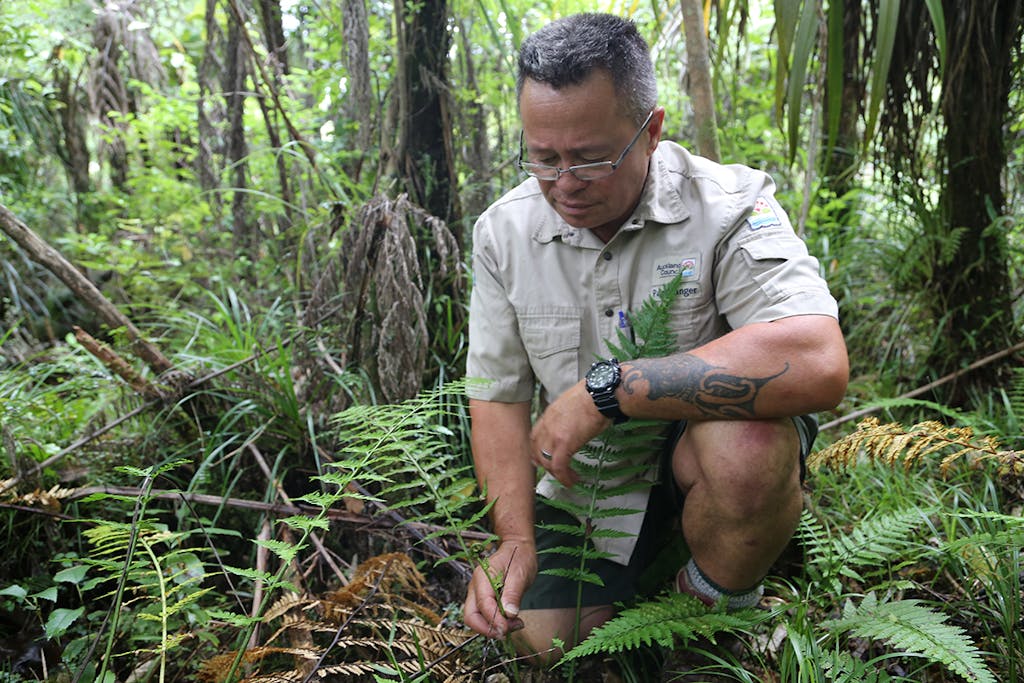
Riki Bennett wants to teach more people how to forage. Photo: Meghan Walker
“Foraging is a mystery – you never know what you’re going to come across,” he says. “When you work in a forestry environment, you’ve always got to keep your eyes open for changes.” noting how foraging transforms throughout the year. “As the season changes, the beauty changes.”
While the necessity for foraging has diminished for Bennett – he no longer has to hop fences into cow paddocks for turnip shoots – he still highly values the art of foraging. “It’s more about keeping the knowledge alive, about what is edible in the forest.”
Bennett has his secret spots, just like any avid forager, but he says in Rotorua among his whanau, it’s more common to share the knowledge. In Auckland, however, he keeps quiet about it. “You don’t want to be sharing all the resources with everybody, otherwise it disappears before you get there!”
While he keeps mum about his personal watercress patch, he still avidly promotes sharing the technique and skill of foraging.
“We are getting lazier as things become easier,” Bennett says, lamenting the lack of foraging know-how among most people. “We lose touch with the land. I think it’s important to stay connected to the land in all sorts of ways, whether it be foraging or gardening.”
He notes with incredulity the cost of organic fruits and vegetables, and how easy it can be to avoid buying over-sprayed and over-priced produce. His ancestors knew the forest as well as most of us know the supermarket. Bennett says edible plants were commonplace on the dinner table when he grew up.
Even though there’s a lack of experts in the field, Bennett is happy to see a resurgence of foraged food interest as native wild edibles begin to make their way onto the restaurant scene. North Canterbury is becoming a magnet for foragers, and last year several of the area’s wineries joined together for an event called the North Canterbury Forage. Chefs, winemakers, and international food and wine writers spent a day foraging for local ingredients which then went into a huge feast to celebrate locally sourced food.
Feilding chef Michael Daly is passionate about having foraged fare on the menu. Daly, originally from Ireland, wrote New Zealand’s first foraging cookbook: Find it, eat it: Cooking foraged food gathered around New Zealand. He now owns a delicatessen and cooking school called The Daly Larder, where his constantly changing menu serves seasonal and local food. The business reflects his wealth of knowledge about wild food, gained on a forage-voyage around the country.
In 2010, Daly moved into a housetruck with his wife and two young sons and traveled the country for two years in search of edible plants. He compiled his findings into his cookbook with the notion that people don’t always have to venture into the countryside to find food. “Head out into your backyard first,” he insists.
From wild strawberries and blackberries to edible flowers and herbs, Daly was able to collect ingredients from north to south, in both rural areas and on seashores. The key to foraging is to find anything that’s growing wild, “because it hasn’t been touched, sprayed, the flavour isn’t altered – it grows naturally.
“People want big shiny apples that they find in the supermarket, but that doesn’t exist in the wild. Just cut the black spots off!” Daly encourages.
Melany Wright from Waikari considers herself lucky because she grew up knowing exactly where her food came from. Her father was an avid hunter, fisher and farmer, and from an early age she learned how to forage in the rural bounties of north Canterbury. Wright’s interest in herbs and weeds flourished in her teens, and she took horticulture classes at Rangiora Academy to learn everything she could about edible greens.
“Weeds are my thing,” Wright says. Her go-to backyard green is plantain leaves: she says both the broadleaf and ribwort varieties are easy to find. Plantain leaves are in the spinach family and neutral on the palate, which makes them great for salads or as a spinach substitute in spanikopita. Wright says the broadleaf variety grows freely by creeks near willow trees, usually in damp, shady spots. Ribwort can grow anywhere, sometimes in open fields. “Most people would have it growing in their gardens, if they just let it be and didn’t spray,” she explains.
“It’s good because it gets you out into your local environment,” Wright says. “And, you learn to live more seasonally.” During fruit harvests, it’s not unusual for her to collect 40kg of fruit, which she then barters, sells, or preserves.
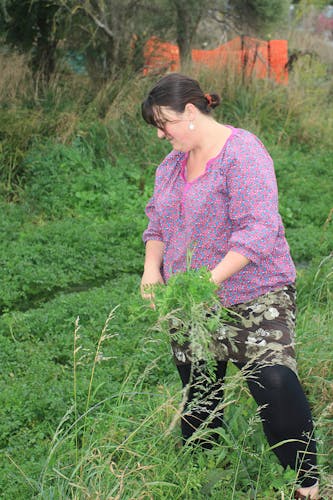
Melany Wright gathering riverside herbs. Photo: Peter Langlands
Wright has three children and foraging for fruits and vegetables allows her to provide healthy food for her family. “I couldn’t afford to buy organic dried fruit – it’s expensive – but for me to go out and pick wild apricots and dry and store them, that’s something that really enriches our lifestyle.”
Wright has become an expert at scanning landscapes for fruit trees, can spot an edible weed while cruising down rural highways and has several hot-spots close to home where she picks herbs like St John’s Wort and chamomile.
Most foragers will tell you to pick from places where the plant you want is growing in abundance. To forage sustainably, this is important. And, to collect her most coveted foraged fare, Wright strictly follows this guideline.
Porcini mushrooms are a treasured find. She still remembers her first porcini, found four years ago in a top-secret location. She was “euphoric”, and remembers exactly how she cooked it: thinly sliced, seared on a hot pan with a little butter and fresh thyme, and topped with a dash of lemon juice.
Wright and her foraging friends have taken an oath of secrecy, promising to never reveal their porcini spot. Porcinis are sold at $100 per kilo, which means any well-known porcini-growing areas are so picked over, the chances of finding a single shroom are slim at best.
Wright’s kids are learning as well, soaking up their mum’s knowledge of backyard edible weeds and learning how to go mushroom hunting. However, they’re still not too keen on mum’s roadkill pâté.
“If I see a rabbit that looks quite fresh, I might stop and the kids will say, ‘Oh no!’.” If it’s been “freshly done,” she’ll take it home, skin it, and freeze it, or make a casserole. “It’s pretty tasty.”
This too, is foraging, Wright says.





